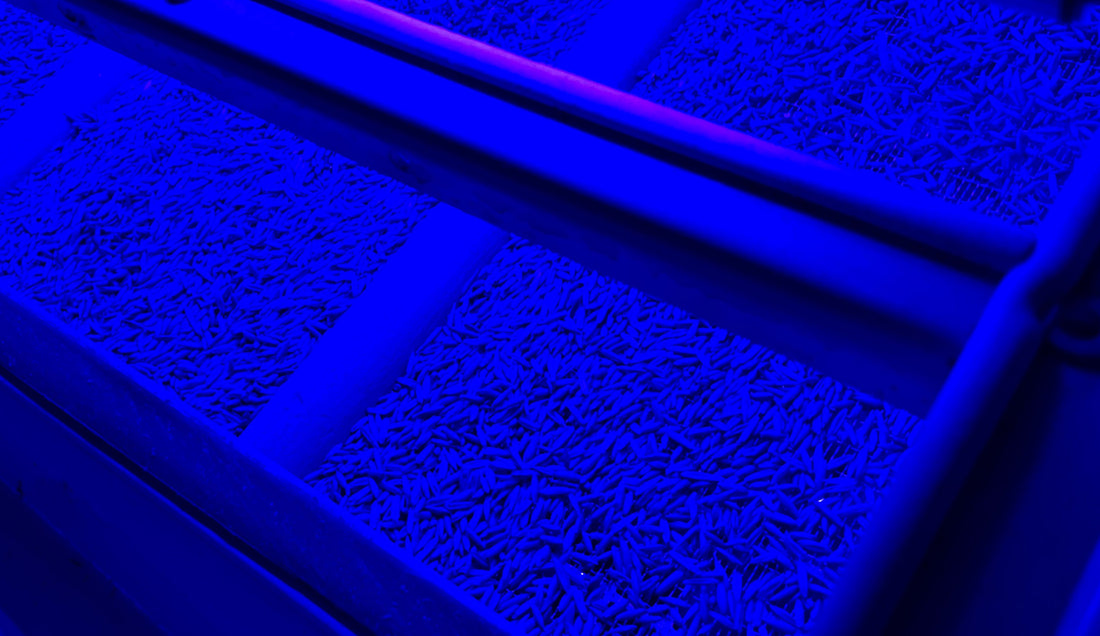
Salvaging Fusarium-Infected Grains with Spectral Blue – Results from the 2023 and 2024 Harvests
Share
Video: Oats being treated with Multi-Wavelength, High-Intensity (MWHI) blue light to reduce DON toxin levels
1. Introduction
Climate change is posing new challenges to our food security, and northern regions are no exception. Warm, moist summers have become more common, increasing the risk of crop losses to molds and their toxins. One of the most problematic molds is Fusarium, which infects grains like oats, wheat, and barley, leading to the production of the harmful mycotoxin deoxynivalenol (DON) in the crops. DON contamination threatens both human and animal health, resulting in strict regulatory limits on its presence in food products.
In 2024, the European Union tightened its limits for DON levels. For example, unprocessed oats now have a maximum limit of 1750 μg/kg to be suitable for human consumption. This Summer (2024), the new regulations and adverse conditions hit several oat farmers hard, especially small, family-run operations, where crop losses due to contamination can lead to severe financial hardship. For some, losing a large portion of their harvest to DON could threaten the very survival of their farm.
As climate conditions worsen, large-scale Fusarium infections may jeopardize entire harvests across regions, triggering food shortages and price surges. Fortunately, new solutions are emerging to help farmers combat Fusarium. One of the most promising is Multi-Wavelength, High-Intensity (MWHI) blue light technology, which has been used successfully to salvage contaminated oats in Finland.
This article explores how Fusarium mold impacts oats in Finland, its consequences on harvests, and how blue light technology can help reduce DON levels in infected grains.
2. Fusarium and Oat Farming
Oats have been a vital crop in Finland for decades, with much of the harvest destined for export. Known for their high nutritional value, oats are a key ingredient in many health-conscious food products. Recently, Finnish farmers have increasingly shifted toward organic oat production to meet the growing demand for sustainable and healthful food.
However, Fusarium infections are a serious threat to oat production, particularly in regions prone to wet conditions. These fungal infections not only damage the crop but can also lead to potentially harmful levels of DON. The severity of contamination varies yearly, influenced by weather, farming practices, and regional factors.
Monitoring programs across Europe track DON contamination in cereals like oats, with regions such as Germany, France, Norway, and the UK often reporting higher DON levels. Several factors, including crop rotation, pre-harvest conditions, and humidity, contribute to the risk of Fusarium contamination. The unpredictability of weather patterns further complicates efforts to control contamination, particularly for organic farmers who have limited chemical intervention options.
3. Innovative Multi-Wavelength Blue Light Technology to the Rescue
Traditionally, farmers had limited options to salvage Fusarium-infected crops. Methods such as drying, sorting, and peeling can reduce contamination but fail to inactivate Fusarium or its toxins. This left many farmers facing significant losses—until now.
At LED Tailor, we’ve spent years developing Spectral Blue Multi-Wavelength, High-Intensity (MWHI) blue light disinfection system, initially designed for cleanrooms, healthcare, and the food industry. Applying this technology to treat contaminated grains was a significant challenge, as grains are often stored in environments with fluctuating temperatures, high humidity, and organic debris. Additionally, treating large volumes of grain in a short time frame requires precise methods.
After collaborating closely with farmers eager to try this new approach and agriculture machine builders, we’ve developed two solutions that successfully reduce DON levels in Fusarium-infected grains.
Arskametalli’s Spectral Seed Solution

Photo 1: Arskametalli's seed cleaner with Spectral Blue technology
In partnership with Arskametalli, we launched the SPECTRAL SEED machine, a vertical tubular sifter with integrated blue light, back in 2018. The results have been promising.
For instance, a farmer in Ostrobothnia, Finland, faced a major crisis with their 2023 harvest of organic oats. Out of 160 tons, 130 tons (81%) were rejected due to DON levels exceeding the new 2024 limit. However, after running the contaminated oats through the Arskametalli Spectral Seed machine, the farmer salvaged 74 tons of the harvest, making it safe for human consumption. With further treatment planned, this innovative blue light solution has already proven to be a game-changer for the farmer.

Table 1: DON reductions after MWHI blue light treatment (only treated batches shown). Maximum allowed DON value for unprocessed oats is 1750 μg/kg
Antti-Teollisuus Horizontal Seed Cleaner

Photo 2: Antti-Teollisuus has integrated Spectral Blue technology into a horizontal seed cleaner
In 2024, we expanded the technology by integrating it into a horizontal vibrating seed cleaner, thanks to feedback from forward-thinking farmers. This solution, developed with Antti-Teollisuus Oy, is already showing great potential.
One farmer in North Ostrobothnia treated batches of oats with DON levels between 1800-4210 μg/kg. After one cycle through the blue light system, DON levels dropped to 300-2010 μg/kg. Although some batches still exceeded the limit, the results showed a significant reduction, allowing the farmer to salvage much of the crop with additional treatment.
4. Further Considerations
While blue light treatment has proven effective, variations between batches mean some may require more than one treatment cycle to achieve safe DON levels. We've found that the process works best in lower temperatures and humidity, where Fusarium growth is slower, allowing the blue light to eliminate toxins more effectively. In some cases, higher temperatures and humidity promote Fusarium activity between cycles, necessitating multiple rounds of treatment.
Overall, blue light technology represents a breakthrough in salvaging Fusarium-infected grains, offering a lifeline to farmers battling against unpredictable weather and contamination. With ongoing refinement and collaboration, the future of blue light solutions looks bright, ensuring safer harvests and more secure food supplies.
Further resources on DON toxins:
- Koneviesti magazine: "Viljojen Fusarium ja mykotoksiinipitoisuudet taas tapetilla – keinoja ongelman selättämiseksi on löytynyt" (2.10.2024, In Finnish)
- Finnish Food Authority: "Fusarium toxins: adult intake from cereals and cereal-based products in Finland" (11 / 2018, In Finnish)
